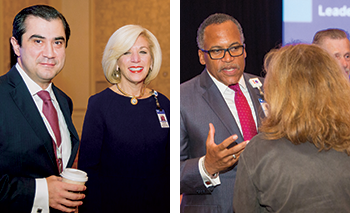-
Services
Featured Specialties
-
Locations
Location Type
-
Patients & Visitors

Left: Senior Vice President Cynthia Sparer, with Murat Gunel, MD, YNHH chief of Neurosurgery, discussed the Patient Experience. Right: Kevin Myatt introduced the FY2016 PIP goals.
Dr. Balcezak introduced what he called the triple-aim of safety and quality: teamwork, leadership and staff behaviors. This is what will bring us to our high-reliability outcomes, which are:
"We have greatly improved the culture of reporting and the ease of reporting serious safety events here," said Dr. Balcezak. "Over the next three years, our goal is to get that number down from about 100 to fewer than 20 in a 12-month period. We are a resilient organization and I know we can do it." None of our goals can be achieved without engaged employees and physicians.
How? By continuing training, morning safety report, rounding, safety coaches and sharing patient safety stories. YNHH will also make structural improvements to achieve standardized safety event follow-up and investigation and fair and just accountability practices.
Clinical redesign
"Both our HRO journey and our clinical redesign efforts will enable us to increase the value of the care we deliver to our patients, decrease the number of adverse events, improve the patient experience, provide more efficient care, optimize the utilization of resources and improve patient-centered outcomes," said Dr. Balcezak. "It's back to the three basics: leadership, teamwork and behaviors."
These are also the goals for the hospital's clinical redesign efforts, shortterm, high-impact projects that drive better, lower-cost care. Focus areas for clinical redesign for the coming year include: Heart and Vascular patient flow; OR supplies and supply delivery; laboratory and CT scan utilization; care delivery model for observation patients; and a virtual hospice.

Sue Fitzsimons, RN, PhD, chief nursing officer, reported on the Magnet journey. September 30, 2015 signaled the end of the data collection phase for YNHH's Magnet application — safety data and patient satisfaction scores, nursing employee engagement scores and other data were collected over the eight rolling quarters. By January 15, 2016, the Magnet demographic data collection tool about all registered nurses is due and by February 1, the Magnet re-designation document is due. Then comes a Magnet site visit in fall 2016.
"May 2011 was a career highlight for many of us, when YNHH achieved Magnet designation status," said Fitzsimons. "I am confident that we can do it again."
Patient Experience
Cynthia Sparer, senior vice president, Operations and executive director, Yale New Haven Children's Hospital, spoke about the Patient Experience at YNHH. "We have had an incredible climb in Patient Experience over the last five years," said Sparer. "2015 was a challenging year for us and we did not achieve all of our goals but we continued to see improvements and are confident in our direction."
According to Sparer, YNHH will continue to rely on the Patient Experience methods that have worked well — MD/PSM partnerships, Patient Experience forums, sharing of best practices and engagement of employees and physicians. "Our goal is to achieve greater consistency in our practices and improvement efforts," she said. "In addition, we will be working this year to align with quality and safety, develop a focused plan for ambulatory services and expand our reward and recognition program for Patient Experience."
Also on the horizon are efforts to improve communication skills, led by Michael Bennick, MD, medical director, Patient Experience, as well as a new Support Services Forum, led by Susan Haufe, executive director, Patient Experience, to align with nursing and physician leadership.
Technology transformation
Daniel Barchi, chief information officer, praised the work of Allen Hsiao, MD, and the Joint Data Analytics Team (JDAT) over the past year in organizing the wealth of data suddenly available through Epic. JDAT also developed common reporting standards to make that data useful. In the past, data was used heavily to report on what had happened; data now can report what is currently happening; and in the next year or two, Barchi envisions data that will be predictive and prescriptive. Barchi complimented the work on Epic optimization over the past year, and the huge boost it has given to quality outcomes and patient safety.
"It's not about technology when you're talking about health care," said Barchi. "It's really 80 percent about people, 15 percent process and only about 5 percent technology. It is really the people here who make us a destination hospital."
Employee and physician engagement
This year, both physicians and employees participated in engagement surveys and leadership in both groups is actively involving staff and physicians in improvement plans.
"We measure our employee engagement regularly and address the concerns that are raised," said Kevin Myatt, senior vice president, chief human resources officer. "But we literally engage our employees through our incredible PIP program, which links employees' performance directly to the hospital goals — safety and quality, Patient Experience, employee engagement and financial performance.
"Given the economics of this state, we are so fortunate to be able to offer a PIP program so that employees have the chance to earn income above and beyond their regular compensation," said Myatt. "It is significant benefit and not one we should take lightly."